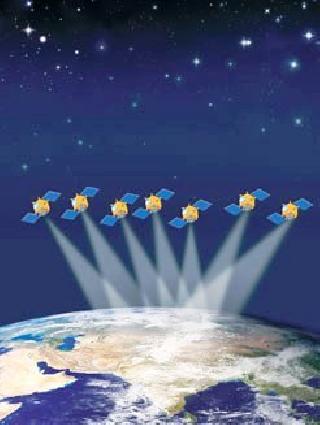
By Ritu Mousumi Tripathy
The Indian Space Research Organisation (ISRO) has charted back-to-back successes in the past six months -- first with the ambitious launch of the Mars Orbiter Mission on 5th November 2013, followed by the launch of the Geosynchronous Satellite Launch Vehicle (GSLV-D5) with indigenous cryogenic engine on 6th January 2014 and, most recently by launching the second regional navigational satellite IRNSS-1B on 4th April, and successfully placing it in circular geosynchronous orbit on 23rd April.
The latest success has enabled India inch closer towards its long-cherished goal of setting up an independent regional space-based navigation system.
The IRNSS-1B is the second of a constellation of seven satellites being planned under the Indian Regional Navigation Satellite System (IRNSS). The first satellite of the series, IRNSS-1A, was successfully orbited on 1st July, 2013, making India enter an elite club of nations capable of operating Sat-Nav system.
Even as the whole world, including India, over the years has increasingly relied on the US' Global Position System (GPS) and Russia's GLONASS system for navigation purposes, possessing an independent satellite navigation network has come to be viewed as a crucial aspect by many countries.
And this has led China to steadily realise the goal of operationalising its indigenous BeiDou Navigation Satellite System, eventually consisting of 35 satellites, to provide navigation services across the globe by the year 2020. China has already orbited more than half of the BeiDou satellites and the system has started offering services across Asia-pacific region from December 2012.
Similarly, the European nations have begun orbiting the Galileo series of navigation satellites with an aim to give independence to Europe from the US' GPS. The European global navigation network, eventually consisting of 30 Galileo satellites, is expected to achieve full operational capability by 2020.
Another new entrant into this independent Sat-Nav zone is Japan, which, like India, has set its eyes on setting up a regional space-based navigation system. The first satellite of the Japanese system, called the Quasi Zenith Satellite System (QZSS), has been successfully orbited in September 2010. The QZSS will consist of four navigation satellites, expected to be operational by 2018.
Though smaller in size and scope compared to the Chinese or European global Sat-Nav systems, India's regional Sat-Nav system nevertheless promises to provide vital services to users in and around the country's periphery.
The wide-ranging applications of IRNSS include terrestrial, aerial and marine navigation to disaster management, vehicle tracking and fleet management to integration with mobile phones, mapping and geodetic data capture among others.
Though ISRO maintains silence over the navigation system's strategic application, the IRNSS certainly promises to provide vital strategic services to the country's defence forces as well.
According to ISRO, the IRNSS is designed to provide position accuracy better than 10m over India and the region extending about 1500 kms around India. The system will provide an accurate real time Position, Navigation and Time (PNT) services to users on a variety of platforms with 24x7x365 service availability under all weather conditions.
Primarily consisting of two segments -- the space segment and ground segment -- the seven satellites under the IRNSS will be positioned at 36,000 km above the Earth's surface. While three of them will be positioned in geostationary orbit, the remaining four will remain in inclined geosynchronous orbit.
Each satellite in the constellation will have a life-span of 10 years.
ISRO intends to put in place the entire IRNSS system by 2015. In 2014 itself, the space agency plans to launch the following two satellites of the series - IRNSS 1C and 1D, which will effectively enable the system to start functioning even with a minimum of four satellites.
While the civilian use of the IRNSS would be innumerable, the system will be a vital asset for India for military applications as well.
The navigation system will not only enable India shed its reliance on the GPS or GLONASS, but will also provide significant strategic advantage to the country's armed forces during military conflicts by allowing them to launch high precision strike weapons, to keep an eye on troops movement and even track potential enemy targets.
Moreover, the Sat-Nav system will be a crucial resource for carrying out modern-day C4ISR operations, thereby enabling the Defence Forces to effectively plan, coordinate and execute network-centric warfare missions even if denied critical and accurate signals from either the GPS or GLONASS.
 Previous Article
Previous Article Next Article
Next Article













The Indian Air Force, in its flight trials evaluation report submitted before the Defence Ministry l..
view articleAn insight into the Medium Multi-Role Combat Aircraft competition...
view articleSky enthusiasts can now spot the International Space Station (ISS) commanded by Indian-American astr..
view article